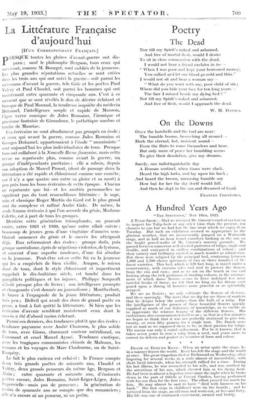A Hundred Years Ago
"THE SPECTATOR," MAY 18TH, 1833.
A Tome Snow.—Had we received Mr. Gitoord's card of invitation to inspect his Tulip-bads at any other time than the present. ton chances to one but we had lost the fine treat which we enjoy.xl on Tuesday. But such an exhibition seemed so appropriate to the glorious weather, that we incontinently jumped on a Walworth stage, and in half an hour found ourselves basking in the sun on the bright gravel-walks of Mr. Caoost's nursery grounds. Wo passed between numerous well-stocked parterres of tulips, single and double, and variegated in endless combinations of colour ; and their variety and brilliancy excited as. much, wonder as admiration. But these were eclipsed by the principal bed, containing between 1,600 and 1,700 choice specimens of two or three hundred of finest varieties. This bed, which is 120 feet long, is raised under a conservatory, with canvass sides and roof to protect the flowers from the sun and rain ; and as we sat on the bench at one end looking along the rich profusion of dazzling colours, in the arrange- ment of which dame Nature scums to have indulged her most tasteful freaks of fancy, we felt that no king on his throne ever gazed upon a throng of beauties more graceful or so splendidly arrayed. We aro no florists ; we only cultivate the flowers of rhetoric, and these sparingly. The roots that we dig for are those of matters that lie deeper below the surface than the bulb of a tulip. But the intelligence of the grower of these beautiful flowers quickly supplied so much of our deficiency of knowledge, as to enable us to appreciate the relative beauty of the different flowers. His enthusiasm also communicated itself to us ; so that in a few minutes we began to think that it was not• perfectly irrational to give ton. twenty, or even fifty guineas for a single root. The Dutch were not so mad as we supposed them to be, in their passion for tulips. The mania was only a rooted enthusiasm. For bo it known, that it takes seven years to rear a tulip from a seed, and years more to correct its defects and perfect its beauties of form and colour.
* * * *
DEATH OF EDMUND KEAN.—When an actor quits the stage, he in a manner leaves the world. Kean has loft the stage and the world at once. The great tragedian died at Richmond on Wednesday, after lingering for several weeks in a state almost of insensibility, with short lucid intervals, when his strength rallied for a time. During his last illness, he was reconciled to his wife, and was soothed by the attentions of his son, which cheered him in his dying hour. Ho had boon in almost a hopeless state since the night when he broke down in the part of Othello at. Covent Garden, having performed with his son then for the first time. The effort proved too much for him. He may almost be said to have " died with harness on his back." His first steps in childhood were on the boards ; and ho tottered from the stage, an old man and worn-out, at five-and-forty. His life was one of continued excitement, mental and bodily.














































 Previous page
Previous page